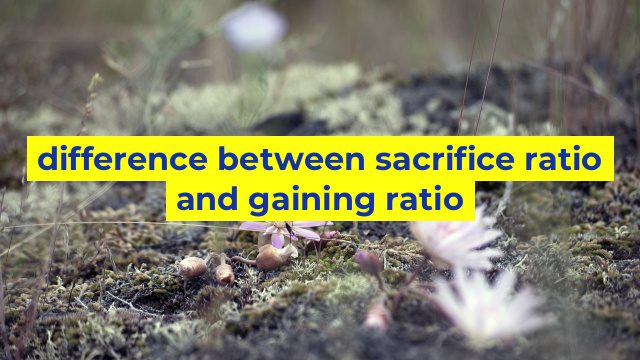Understanding the Difference between Sacrifice Ratio and Gaining Ratio in Economics
The terms “sacrifice ratio” and “gaining ratio” are commonly used in the field of economics to describe the cost and benefits of implementing economic policies. While both terms are related to the trade-offs involved in economic decision-making, they are fundamentally different in their meanings and implications. In this article, we explore the difference between sacrifice ratio and gaining ratio and how they impact economic decision-making.
What is Sacrifice Ratio?
Sacrifice ratio is a term used in macroeconomics to describe the cost of reducing inflation through monetary policy. This term is based on the idea that reducing inflation requires a temporary increase in unemployment, which is considered a “sacrifice” for achieving long-term price stability. The sacrifice ratio is calculated using the formula:
Sacrifice Ratio = (Peak Inflation Rate – Target Inflation Rate)/Percentage Change in Output
In simple terms, the sacrifice ratio measures the percentage decline in output that must occur to achieve a one-percentage-point reduction in the inflation rate. A higher sacrifice ratio indicates a higher cost of reducing inflation, while a lower ratio indicates a lower cost.
What is Gaining Ratio?
Gaining ratio, on the other hand, refers to the benefits of economic policies that generate positive externalities. Positive externalities are the economic benefits that spill over to others outside of the direct beneficiaries. For instance, investments in education have a positive externality as they benefit the individual and the society at large by creating a more knowledgeable workforce. The gaining ratio measures the benefits generated by an economic policy as a ratio of the cost incurred.
Gaining Ratio = Economic Benefit/Cost
In general, a higher gaining ratio is favorable as it indicates that the benefits of the policy exceed the costs incurred. A lower gaining ratio, on the other hand, signals that the costs outweigh the benefits, making the policy an inefficient use of resources.
Conclusion
In conclusion, sacrifice ratio and gaining ratio are important economic concepts used to evaluate the trade-offs involved in economic decision-making. While the sacrifice ratio measures the cost of reducing inflation through monetary policy, the gaining ratio measures the benefits generated by economic policies that generate externalities. By understanding the difference between these two ratios, policymakers can make informed decisions that optimize economic outcomes while mitigating any negative impacts.
Table difference between sacrifice ratio and gaining ratio
Table showing the difference between Sacrifice Ratio and Gaining Ratio
| Criteria | Sacrifice Ratio | Gaining Ratio |
|---|---|---|
| Definition |
Sacrifice ratio refers to the ratio of the short-run loss of production to the long-run gain of price stability. |
Gaining ratio refers to the ratio of the short-run gain in production to the long-run gain of price stability. |
| Goal | To reduce inflation and stabilize prices. | To increase production and stabilize prices. |
| Calculation | [(Percentage decrease in output)/(Percentage decrease in price level)]*100 | [(Percentage increase in output)/(Percentage decrease in price level)]*100 |
| Result | A higher sacrifice ratio indicates a higher cost to reduce inflation. | A higher gaining ratio indicates a greater benefit from increasing production. |
| Application | Used by policymakers and central banks to determine the appropriate level of contractionary monetary policy. | Used by policymakers and central banks to determine the appropriate level of expansionary monetary policy. |


